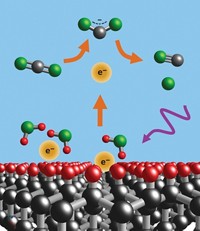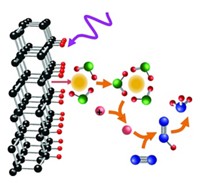Advertisement
Grab your lab coat. Let's get started
Welcome!
Welcome!
Create an account below to get 6 C&EN articles per month, receive newsletters and more - all free.
It seems this is your first time logging in online. Please enter the following information to continue.
As an ACS member you automatically get access to this site. All we need is few more details to create your reading experience.
Not you? Sign in with a different account.
Not you? Sign in with a different account.
ERROR 1
ERROR 1
ERROR 2
ERROR 2
ERROR 2
ERROR 2
ERROR 2
Password and Confirm password must match.
If you have an ACS member number, please enter it here so we can link this account to your membership. (optional)
ERROR 2
ACS values your privacy. By submitting your information, you are gaining access to C&EN and subscribing to our weekly newsletter. We use the information you provide to make your reading experience better, and we will never sell your data to third party members.
Synthesis
Gas Gobblers Reject Hydrogen
Calixarene crystals snatch up CO and CO2 but let H2 run right on through
by Stephen K. Ritter
May 31, 2004
| A version of this story appeared in
Volume 82, Issue 22

Nonporous crystals of a calixarene dimer have been found to selectively absorb and retain CO, CO2, and other gases while mysteriously neglecting H2. The chemists who discovered this phenomenon believe the organic crystals could be used like activated carbon or zeolites to purify hydrogen for use in fuel cells [Angew. Chem. Int. Ed., 43, 2948 (2004)].
Chemistry professor Jerry L. Atwood and graduate student Agoston Jerga of the University of Missouri, Columbia, and chemistry professor Leonard J. Barbour of the University of Stellenbosch, in South Africa, came across the calixarene’s discriminating behavior while following up on their earlier work involving calixarenes.
In 2002, the researchers noticed that p-tert-butylcalix[4]arene forms a crystalline phase in which the cup-shaped molecules dimerize. The open ends of the “cups” join together via van der Waals interactions, leaving an hourglass-shaped cavity. They found that the crystals could absorb liquids, such as vinyl bromide, confining single molecules in the cavities.
In the new experiments, the researchers observed that the crystals also soak up gases when stored in air. They found this out when calixarene crystals were submerged in nitrobenzene and air bubbled out of the crystals. On further exploration, they found that crystals exposed to about 1 atm of CO2 function as vacuum pumps, absorbing the gas until the pressure drops to about 0.05 atm. The crystals also can absorb CO, N2, and O2, the researchers note, but not as rapidly or to such a high degree. The clincher for the team was the observation that the calixarene crystals absorb CO2 from a CO2-H2 mixture, leaving the H2 behind.
Hydrogen produced from water and CO in the water-gas shift reaction is contaminated with CO and CO2, Atwood says, and separating the H2 is complicated and expensive. Even though it’s uncertain how the seemingly nonporous calixarenes absorb gases, he believes the material could be useful for H2 purification.
A reusable H2 purification system for fuel cells would be an important development for the automotive industry, notes inorganic chemist Jonathan W. Steed of the University of Durham, in England. A number of materials are known that will absorb CO and CO2, he says, but better materials are needed. What’s interesting about the calixarenes is that the structure is very well defined and the researchers understand quantitatively how the heavier gases are absorbed, Steed adds. This means they can modify their materials in a systematic way to optimize them.
“This science is just breathtaking,” Steed concludes. “Not just for its potentially vast applications, but also as an intellectual result that will help us better understand the phenomenon of absorption of gases by solids.”





Join the conversation
Contact the reporter
Submit a Letter to the Editor for publication
Engage with us on Twitter